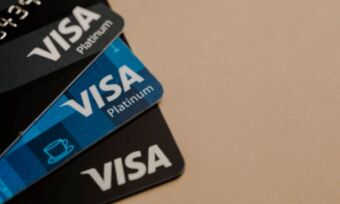The Apple Card is currently only available to customers in the United States. The credit card first rolled out back in 2019 and there is still no word on if or when it will hit Australian shores.
Although the Apple Card is not currently offered outside of the US, here’s a look at how it works.
What is the Apple credit card?
The Apple Card is a Mastercard created in partnership with banking and investment giant Goldman Sachs. It is primarily a digital card, accessible through the Wallet app and integrated with Apple Pay. When you click on the Wallet app, you can make payments as well as see your transactions and account details.
Customers can also order a physical titanium card. The card can be used anywhere Mastercard is accepted, so it could be used with retailers that don’t accept Apple Pay. The metal card has no numbers or other secure information on it; instead, this information is stored in your Wallet app.
It lives in the Wallet app. And in your wallet.
Learn more about Apple Card at https://t.co/py9EN04GiQ.
For support-related questions, contact @AppleSupport.— Apple Card (@AppleCard) August 20, 2019
What does the Apple credit card offer?
Cashback
One of the most talked-about features of the Apple Card is its ‘Daily Cash’ feature. This allows customers to get up to 3% cash back with every purchase, with no limit on how much you can receive. Apple currently offers three percentage tiers:
- 3% back on Apple purchases and other select retailers including Nike, Uber and Uber Eats using Apple Pay
- 2% back on other purchases using Apple Pay
- 1% back on purchases made using the physical titanium card in store or Apple Card number online
Cash is deposited daily onto your Apple Cash card. You can set up an Apple Cash card through the Settings app and it will then live in the Wallet app. Apple Cash can then be used to make purchases using Apple Pay, pay your Apple Card bill, sent to someone in the Messages app or transferred to your bank account.
After 24 hours from purchasing with #AppleCard you will see your Rewards on your #AppleCash card. pic.twitter.com/avTEsAV3tC
— Carolina Milanesi (@caro_milanesi) August 6, 2019
No fees
The Apple Card has no annual, over-the-limit, foreign transaction or late fees. However, if you don’t pay off your monthly balance by the due date, you will be charged interest.
Interest rates
In the US, the interest rates currently range from 10.99% to 21.99% (as of 1 April, 2020) based on the applicant’s creditworthiness. Aussie consumers will have to wait to see how Apple’s interest rates could stack up here, however, it’s important to make sure you compare a credit card’s interest rate, fees and features before signing up. It’s also a good idea to always read the Product Disclosure Statement (PDS) and Target Market Determination (TMD) that apply for financial products.
Interest estimator tool
Speaking of interest charges, the Apple Card also offers an interest estimator tool. When you’re ready to pay your credit card bill, Apple says it will estimate how much interest you’ll pay based on the payment amount you choose to make. This is done in real time, Apple says, so you can decide how much you want to pay down and potentially keep interest payments to a minimum.
Budgeting tools
Through the Wallet app, you can also monitor your spending by week or month. Your spending is categorised so you can track how much you spend on things like entertainment, food, shopping and more. While there are no plans for Apple to launch the Apple Card in Australia at the time of writing, you could be interested in budgeting and finance apps available now, plus discover more about the budgeting tools offered in the Canstar App (powered by Frollo).
Family finances
Apple also recently introduced Apple Card Family, which allows you to add your partner and other family members to your account. You can currently share your Apple Card with a ‘co-owner’, which essentially means you can create a joint account with a partner. You can also add up to four ‘participants’ to your account, such as other family members, and you can view their spending and set spending limits.
What are potential drawbacks of the Apple credit card?
The Apple Card is only really suited to Apple users. The Apple Card lives in the Wallet app and in order to receive cashback you’ll need to set up an Apple Cash card. At the time of writing too, the card is not available in Australia, as we’ve already mentioned.
“One of the main drawbacks of the Apple credit card, when compared to other options, is how reliant it is on the consumer to be fully integrated within the Apple ecosystem – as without an iPhone, you will be unable to view statements, make repayments or even apply for the card in the first place,” said Canstar’s Rating Manager, Joshua Sale.
Additionally, you’ll need to use Apple Pay in order to snag the higher 3% and 2% cashback rates in the US. If you pay using the physical Apple Card, you’ll only receive 1% cashback on purchases in the US.
And while the tech behemoth claims the Apple Card ‘rethinks’ everything about credit cards, Mr Sale isn’t convinced that it would make much of an impact, if it were to be launched in the Australian market.
“There is little that would set the Apple credit card apart from other options available in the Australian market, with a number of credit cards offering benefits such as no fees or cashback reward options,” he said.
Mr Sale also noted that Apple could find it difficult to offer the same cashback percentages to Aussie consumers.
“Providing this level of reward return could prove challenging in Australia’s highly competitive credit card market. The Australian market is dominated by bank issuers who are regulated in a way that effectively puts a ceiling on Australian card issuers’ ability to provide attractive reward returns,” he said.
- 0% interest on general purchases in first 9 months when approved by 12 Jan 2026. T&Cs, annual card fee & other charges apply. Excludes other offers. New customers only
Australian Credit Licence 392145
- Fill your shopping trolley with a $250 Coles gift card when you apply for a new Coles Rewards Mastercard by 17 March 2026. T&Cs apply.
Australian Credit Licence 230686
- Save with a 0% p.a. interest rate on balance transfers for 20 months (with a 3% balance transfer fee). Plus, a low 13.74% p.a. purchase interest rate.
Australian Credit Licence 233714
- $0 annual fee 1st year (normally $96) & earn up to $500 in Latitude Rewards in yr 1. Min spend on eligible purchases applies. New approved customers by 26 Feb 2026
Australian Credit Licence 392145
- 0% p.a. for 10 months on balance transfers (1% fee)
- Award winning no annual fee rewards credit card
- Complimentary FIRST membership valued at $129/year
Australian Credit Licence 230686
- $300 credit back. Spend $1.5K+ p/m on general purchases in 1st 4 months. T&Cs, mthly credit card fee $10.95 & other charges apply, new customers approved by 17Feb26
Australian Credit Licence 392145
Australian Credit Licence 233714
Australian Credit Licence 244310
Australian Credit Licence 234527
Australian Credit Licence 234527
This article was originally published in August 2019 and has been updated.
Cover image source: DGLimages/Shutterstock.com







